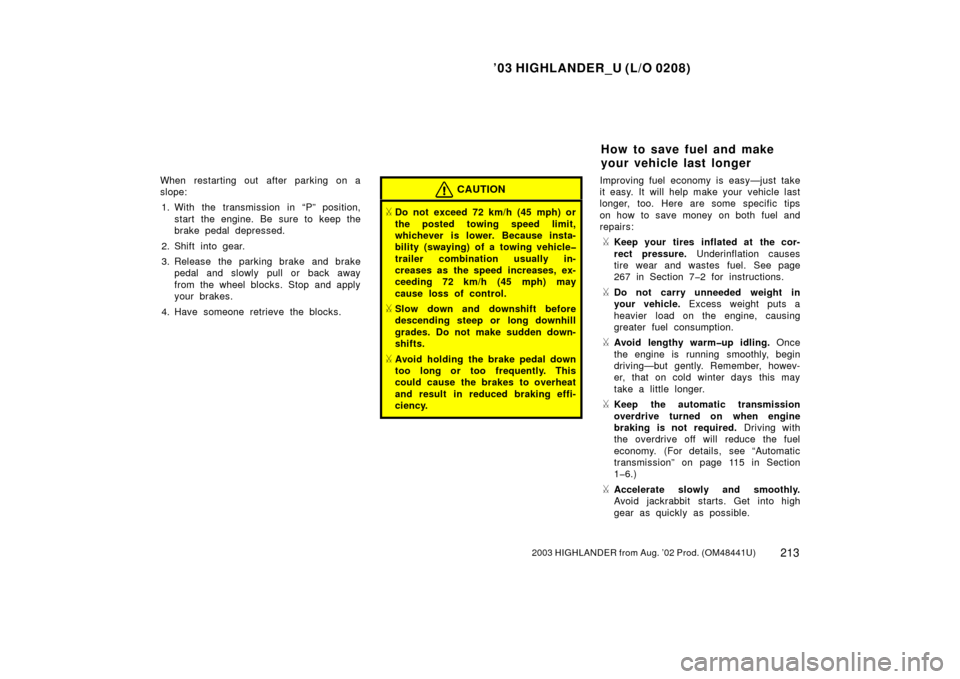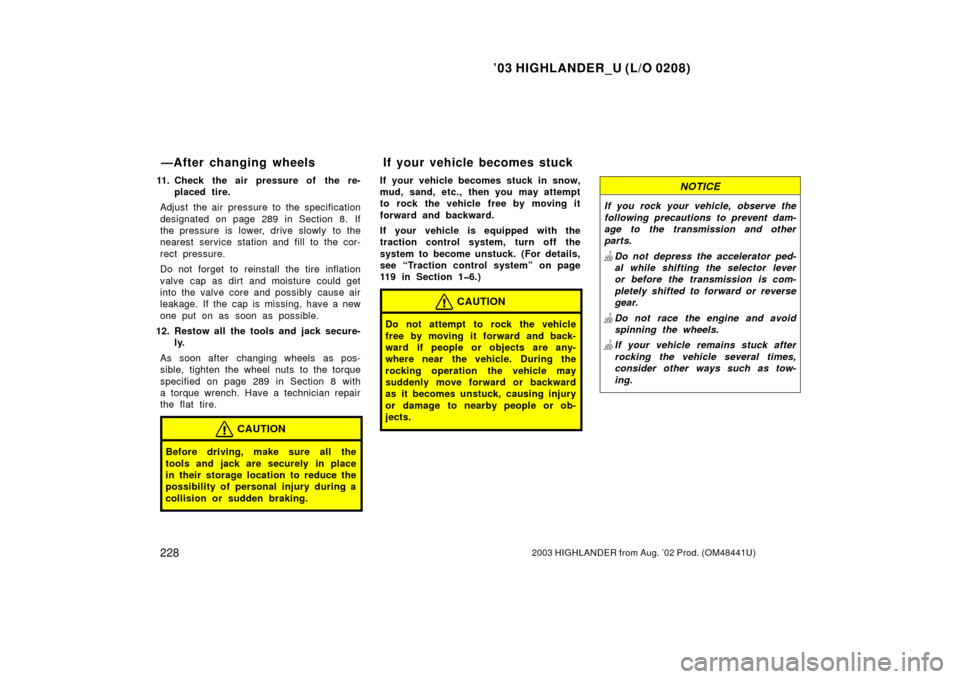Page 219 of 303

’03 HIGHLANDER_U (L/O 0208)
2132003 HIGHLANDER from Aug. ’02 Prod. (OM48441U)
When restarting out after parking on a
slope:
1. With the transmission in “P” position, start the engine. Be sure to keep the
brake pedal depressed.
2. Shift into gear.
3. Release the parking brake and brake pedal and slowly pull or back away
from the wheel blocks. Stop and apply
your brakes.
4. Have someone retrieve the blo cks.CAUTION
�Do not exceed 72 km/h (45 mph) or
the posted towing speed limit,
whichever is lower. Because insta-
bility (swaying) of a towing vehicle�
trailer combination usually in-
creases as the speed increases, ex-
ceeding 72 km/h (45 mph) may
cause loss of control.
�Slow down and downshift before
descending steep or long downhill
grades. Do not make sudden down-
shifts.
�Avoid holding the brake pedal down
too long or too frequently. This
could cause the brakes to overheat
and result in reduced braking effi-
ciency.
Improving fuel economy is easy—just take
it easy. It will help make your vehicle last
longer, too. Here are some specific tips
on how to save money on both fuel and
repairs:
�Keep your tires inflated at the cor-
rect pressure. Underinflation causes
tire wear and wastes fuel. See page
267 in Section 7�2 for instructions.
�Do not carry unneeded weight in
your vehicle. Excess weight puts a
heavier load on the engine, causing
greater fuel consumption.
�Avoid lengthy warm�up idling. Once
the engine is running smoothly, begin
driving—but gently. Remember, howev-
er, that on cold winter days this may
take a little longer.
�Keep the automatic transmission
overdrive turned on when engine
braking is not required. Driving with
the overdrive off will reduce the fuel
economy. (For details, see “Automatic
transmission” on page 115 in Section
1�6.)
�Accelerate slowly and smoothly.
Avoid jackrabbit starts. Get into high
gear as quickly as possible.
How to save fuel and make
your vehicle last longer
Page 234 of 303

’03 HIGHLANDER_U (L/O 0208)
2282003 HIGHLANDER from Aug. ’02 Prod. (OM48441U)
11. Check the air pressure of the re-
placed tire.
Adjust the air pressure to the specification
designated on page 289 in Section 8. If
the pressure is lower, drive slowly to the
nearest service station and fill to the cor-
rect pressure.
Do not forget to reinstall the tire inflation
valve cap as dirt and moisture could get
into the valve core and possibly cause air
leakage. If the cap is missing, have a new
one put on as soon as possible.
12. Restow all the tools and jack secure- ly.
As soon after changing wheels as pos-
sible, tighten the wheel nuts to the torque
specified on page 289 in Section 8 with
a torque wrench. Have a technician repair
the flat tire.
CAUTION
Before driving, make sure all the
tools and jack are securely in place
in their storage location to reduce the
possibility of personal injury during a
collision or sudden braking.
If your vehicle becomes stuck in snow,
mud, sand, etc., then you may attempt
to rock the vehicle free by moving it
forward and backward.
If your vehicle is equipped with the
traction control system, turn off the
system to become unstuck. (For details,
see “Traction control system” on page
119 in Section 1�6.)
CAUTION
Do not attempt to rock the vehicle
free by moving it forward and back-
ward if people or objects are any-
where near the vehicle. During the
rocking operation the vehicle may
suddenly move forward or backward
as it becomes unstuck, causing injury
or damage to nearby people or ob-
jects.
NOTICE
If you rock your vehicle, observe the
following precautions to prevent dam-
age to the transmission and other
parts.
� Do not depress the accelerator ped-
al while shifting the selector lever
or before the transmission is com-
pletely shifted to forward or reverse
gear.
� Do not race the engine and avoid
spinning the wheels.
� If your vehicle remains stuck after
rocking the vehicle several times,
consider other ways such as tow-
ing.
—After changing wheels If your vehicle becomes stuck
Page 274 of 303

’03 HIGHLANDER_U (L/O 0208)
2682003 HIGHLANDER from Aug. ’02 Prod. (OM48441U)
CAUTION
Keep your tire pressure properly.
Otherwise, the following conditions
may occur and cause an accident re-
sulting in death or serious injuries.
Low tire pressure (underinflation)—
�Excessive wear
�Uneven wear
�Poor handling
�Possibility of blowouts from over-
heated tire
�Poor sealing of the tire bead
�Wheel deformation and/or tire sepa-
ration
High tire pressure (overinflation)—
�Poor handling
�Excessive wear at the center of the
tire tread
�A greater possibility of tire damage
from road hazards
The following instructions for checking
tire pressure should be observed:
�The pressure should be checked only
when the tires are cold. If your ve-
hicle has been parked for at least 3
hours and has not been driven for
more than 1.5 km or 1 mile since, you
will get an accurate cold tire pressure
reading.
�Always use a tire pressure gauge.
The appearance of a tire can be mis-
leading. Besides, tire pressures that
are even just a few pounds off can
degrade ride and handling.
�Do not bleed or reduce tire pressure
after driving. It is normal for the tire
pressure to be higher after driving.
�Never exceed the vehicle capacity
weight. The passenger and luggage
weight should be located so that the
vehicle is balanced.
�Be sure to reinstall the tire inflation
valve caps. Without the valve caps,
dirt or moisture could get into the valve
core and cause air leakage. If the caps
have been lost, have new ones put on
as soon as possible.
Tread wear indicator
CHECKING YOUR TIRES
Check the tire tread for the tread wear
indicators. If the indicators show, re-
place the tires.
The tires on your Toyota have built�in
tread wear indicators to help you know
when the tires need replacement. When
the tread depth wears to 1.6 mm (0.06
in.) or less, the indicators will appear. If
you can see the indicators in two or more
adjacent grooves, the tire should be re-
placed. The lower the tread, the higher
the risk of skidding.
The effectiveness of snow tires is lost
if the tread wears down below 4 mm
(0.16 in.).
Checking and replacing tires